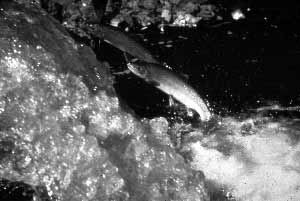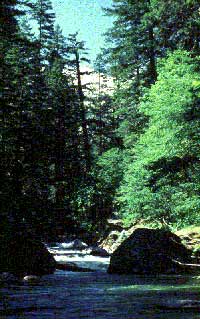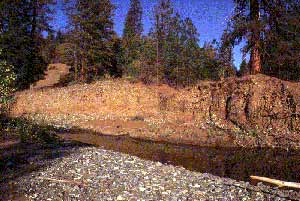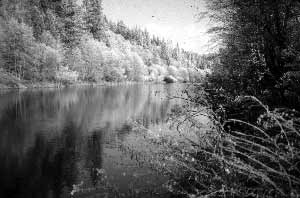
|
| Spring 1999
| Special Issue--Riparian Health
| Vol. VIII, No. 2
|
In This Issue:
| Upcoming Riparian Workshops
- May 15 -- Weaverville at the County Library
- June 12 -- Lewiston at Lewiston Community Center
- July 10 -- Big Bar at the Down River Resource Center
- September -- Hayfork at the Hayfork Fairgrounds
(date to be announced)
All workshops will begin at 9:00 a.m. and finish by 12:00 noon
Children's games and activities provided for ages 6-12
|
Focus On
Riparian Health
You will notice that this issue of the Conservation Almanac is dedicated to one topic – the health of our county's riparian areas, and you may be wondering why? There are some basic reasons for us to focus on these vital edges of our county's rivers and streams. Trinity County's rivers and streams are the life blood of our communities. These ribbons of water are essential to our livelihoods – they provide our drinking water, irrigate our fields and gardens, provide recreation, support tourism, sustain our fisheries and provide travel corridors and habitat for wildlife. The riparian areas are the transition zones between the water and the rest of the landscape. They add complexity to the stream edges, filter the water that runs off the land into the streams, and enhance the overall quality of the water resources that we depend upon. In one sense the riparian edges of streams act as a cushion between the streams and the uplands. Streams that have had the vegetation removed are not
functioning as well as streams with a band of trees and shrubs along the banks.
There is another reason that we are putting an emphasis on these riparian areas, one that folks don't like to dwell on, but is a reality with which we must struggle – there are regulations that have been imposed upon us, and others that have been proposed, that could affect the way we conduct our lives and do business in Trinity County. Our hope is that, working with the other northern coastal counties, we can develop strategies that show the regulatory agencies that we have the collective will and ability to address their issues on a voluntary basis and that they need not rely on regulations. Towards that end, the District, in cooperation with the Natural Resources Conservation Service and Trinity County, has developed a half-day workshop on caring for riparian areas that will be offered throughout Trinity County beginning in mid-May. These workshops are designed for anyone with an interest in the subject, especially riparian landowners. There will even be special activities for the
children. We really hope that you can join us when the workshop comes to a location near you – Weaverville, Lewiston, Big Bar or Hayfork – and we hope that through this type of locally-led stewardship effort we can make a difference.
Return to This Issue's index.
| Common Terms
Riparian: area alongside
streams, normally vegetated
Anadromous: fish that spawn
in fresh water and mature at sea
Salmonid: refers to fish in the
trout and salmon family
Runoff: water that travels over
land into streams
Vegetation: the total plant
cover or plant life of an area
Habitat: the environment or
place where a plant or animal
naturally lives
|
Regulations: The Carrot or the Stick?
The five northern California counties of Del Norte, Humboldt, Mendocino, Siskiyou and Trinity make up the California portion of the Trans-Boundary Evolutionary Significant Unit for the coho salmon. Native coho salmon populations in this area were listed as federally threatened under the Endangered Species Act (ESA) on August 11, 1997. The steelhead trout was classified as a candidate species for listing on March 13, 1998, and the chinook salmon population status is being reviewed by the National Marine Fisheries Service (NMFS). A status review is on-going regarding the population levels of sea run cut throat trout.
In addition to the salmon listing, a court-approved consent decree stipulated that sediment, temperature or dissolved oxygen Total Maximum Daily Load (TMDL) standards would be established for 18 river basins within the counties. The EPA and North Coast Regional Water Quality Control Board are the lead agencies in developing the TMDL plans, which will be applicable to landowners in these river basins. The close link between fisheries habitat management and the sediment/temperature TMDL standards provide the necessity to address both issues in a single comprehensive plan.
The link between land use, wildlife habitat, fisheries resources and water quality have become dominant influences in social, economic and recreational development patterns for the northwestern California counties over the past decade. The counties' Boards of Supervisors have chosen to actively participate in the recovery process for anadromous species and water quality, because they feel strongly that neither the state or federal government is as capable of balancing local land use regulations,while meeting the requirements of the regulations. This plan recognizes that county and watershed boundaries are not the same and there is a need to develop a watershed approach to county decision-making processes.
The Boards hope to contribute to efforts to avoid the social and economic impacts that have been associated with previous federal listings, particularly the northern spotted owl. The owl's listing as a threatened species contributed to a much more rapid reduction of logging, trucking and lumber milling and supporting jobs than may have occurred otherwise. The rapid job losses disrupted local economies, increased social impacts and reduced county revenues. During that period, the counties had little direct involvement in either determining the process or outcome of the changes in their communities.
 The interim Conservation Plan is intended to provide standards that decision-makers, land use planners, surveyors and other county land managers can follow to avoid adverse effects to anadromous species habitat. For projects that are within the thresholds of the plan, the potential delay for ESA consultation and the cost of preparing biological assessments are avoided. The plan will not preclude land use activities that exceed these standards, but additional biological evaluation may be necessary in these instances. The interim Conservation Plan is intended to provide standards that decision-makers, land use planners, surveyors and other county land managers can follow to avoid adverse effects to anadromous species habitat. For projects that are within the thresholds of the plan, the potential delay for ESA consultation and the cost of preparing biological assessments are avoided. The plan will not preclude land use activities that exceed these standards, but additional biological evaluation may be necessary in these instances.
The planning process has included a review of County management practices that affect anadromous species habitat in each county; recommendations for changes in County ordinances and/or practices as necessary; development of a watershed based education/training program for local agencies and decision makers that fosters better understanding between land use, maintenance practices and salmonid habitat; and provides a linkage between this short-term planning effort and long-term efforts, including the Governor's Watershed Protection and Restoration Council planning efforts and watershed-based community planning efforts.
The Boards recognized that regulations have been applied to watersheds that cross county political boundaries. To be effective, local land use activities would need to assure the protection of habitat throughout the species' range. From coastal estuaries to inland spawning and rearing streams, the counties are linked to each other to assure that fish stocks recover, economies are protected and the impacts on our communities are minimized.
Part of this watershed-based education/training is the Riparian Landowners Workshops that are being sponsored by the Trinity County Resource Conservation District through a grant from the Natural Resources Conservation Service. By attending one of these workshops, landowners can take an active role in what they can do to enhance salmonid habitat which might be included on their property. Dates and locations of these workshops are included in this newsletter on page 1.
It is the hope of all involved in this new plan that the Trinity County community will embrace these ideas of preventative maintenance for salmonid habitat, as well as become a model of success for other communities to follow.
Return to This Issue's index.
Outline of Riparian Workshops in the Trinity County Area
SUMMARY OF INTERESTS
- Helpful techniques for water quality maintenance for private landowners.
- Insightful information that will be assembled in packet form for continuous reference, including resource addresses and phone numbers.
- Resource professionals at workshop to answer questions.
- Children's games and activities provided in separate room (salmon games, bird house making and many more activities full of fun). For ages 6-12.
Return to This Issue's index.
| WORKSHOP OUTLINE
- Introduction and Background
- Regulatory Issues
- Water Quality Concerns
- Endangered Species Act
- Characteristics of Healthy Riparian Areas:
What are they? Why are they important?
- Definition of Riparian
- Importance to Ecosystem
- Characteristics/Traits of Riparian Areas
- Fish Habitat
- Riparian Vegetation
- Wildlife
- Working With Streams
- Stream bank stabilization
- Storm effects
- Vegetation Management
- Assistance Programs
- Evaluations
|
| The following illustrates the difference between a healthy, properly functioning riparian area, and one that is in a degraded condition. Use the characteristics listed below to determine if your stream is healthy.
|

| 
|
Healthy Riparian
- Cool, clear water
- High water table
- Higher late summer flows
- Vegetated banks
- Varied stream areas; deep pools, shallow water, ripples
- Organic debris (branches, leaves, and logs) in and around stream
- Abundance of wildlife; birds, fish, amphibian, and invertebrates
- Little or no bank erosion
| Unhealthy Riparian Condition
- Warm water contaminated with pollutants
- Low water table
- Reduced summer flows
- Little or no vegetation on banks
- No stream variation
- No organic debris
- Little or no wildlife
- Eroding banks
|
| Return to This Issue's index.
|

Landowner Guide to Stream Care
There are a numerous ways in which landowners can help protect or aid in the recovery of riparian areas. The simplest and often most effective action a landowner can take is to simply leave the stream to its natural processes, and avoid disturbing riparian areas as much as possible. Use the guidelines listed below to maintain a healthy and properly functioning stream system. If you would like to learn more about evaluating your creek and techniques for improving riparian areas, plan on attending one of the upcoming Riparian Workshops to be held in Trinity County. Please see page 1 and 7 for more information on these workshops.
- Reduce erosion -
- Sediment entering into streams and rivers is the main pollutant that reduces water quality and degrades fish habitat, especially for salmonid species. Sediment entering into streams and rivers can bury important habitat for fish, particularly the spawning gravels that are needed for salmon. Landowners should try to prevent, or at least minimize, muddy runoff water from construction, agricultural or other developed sites from entering into streams. It is especially crucial for landowners to avoid disturbing erodible soils during the wet, rainy season when silt runoff is at its peak.
- Maintain streamside vegetation -
- Healthy stream banks are naturally vegetated with a lush, dense growth of riparian plants. Such vegetation plays a crucial role in stabilizing banks and preventing soil erosion, due to the extensive network of roots that binds soils in place. Riparian vegetation also is important for providing canopy shade over the creek, which helps to cool stream temperatures and adds the organic material that provides nutrients for aquatic insects. The diversity of plants in riparian areas also provides a wealth of habitat for birds, mammals, and aquatic wildlife. Streamside vegetation is also important for filtering pollutants from adjacent, upland areas. Landowners can negatively impact streamside vegetation by removing it from banks, spraying herbicides, clearcutting streamside areas, and overgrazing by livestock. Such impacts can lead to increased erosion, channel widening, lowered water table, and elevated water temperatures. Landowners can minimize such impacts by maintaining riparian
vegetation, controlling invasive species such as Himalayan blackberry, and re-planting native plants. Common native riparian shrubs and trees in Trinity County that can be planted along streams include willows (black, red arroyo), white alder, California bigleaf maple, and black cottonwood.
- Leave natural debris -
- Such debris is commonly deposited during winter when high water flows flush streams and carry debris throughout the stream channel. Landowners often remove this debris, incorrectly thinking that it is detrimental to the creek or simply unsightly. Landowners should leave natural debris such as stumps and fallen trees or boulders in the stream. Such debris provides protective habitat for fish and other aquatic wildlife, and adds valuable organic materials that are nutrients for aquatic wildlife, particularly the aquatic insects that are the food source for fish and amphibians.
- Maintain water quality -
- Streams are negatively impacted by a number of pollutants that commonly enter into them, including excess fertilizers, lawn and garden herbicides, pesticides, agricultural runoff, and livestock waste. The effects of such impacts have the potential to be quite severe, with entire aquatic communities damaged or destroyed, and water unsafe for human consumption. Landowners can ensure high water quality of their streams by not spraying chemicals like herbicides or pesticides on or near riparian areas, reducing fertilizer use on lawns, and keeping livestock out of creeks.
- Avoid damming streams -
- Water is one of the key features of a riparian system, and a year-round flow, of cool, clear water is an indication of a healthy stream. Interrupting or decreasing this flow can have major impacts on the stream channel, streamside vegetation, and aquatic wildlife. In northern California water is diverted from streams mainly through damming and storage of water in reservoirs. In Trinity County water is commonly diverted from streams for household use or agricultural purposes. Such diversions can severely reduce stream flows during the summer months, which can adversely impact available habitat for fish and other aquatic wildlife.
- Reduce livestock impacts -
- Livestock tend to congregate in riparian areas, where there is easy access to dense forage, water, and shade. If not managed properly livestock will trample banks, compact soil, and denude vegetation; all which lead to excessive bank erosion. Heavy livestock use, with animals defecating in streams, can also degrade water quality by introducing bacteria such as giardia and E. coli. Landowners can easily reduce livestock impacts by fencing off riparian areas and keeping livestock away from streams. A well-managed grazing regime, where livestock are allowed into the riparian areas for short a duration of time, seems to be the best way to minimize livestock impacts on the riparian areas while still using these regions for grazing. Riparian pastures often are best used for short-duration grazing, where livestock are removed before they damage stream banks and where stubble height of grasses is at least 3 to 8 inches.
- Avoid channel disturbance -
- Disturbing streams often alters the natural meandering of the channel, which leads to changes in water velocity and sediment runoff. The most common disturbances are a result of operating heavy equipment in the stream channel and removing, or disturbing, channel bed materials. Such disturbances can harm spawning and riffle beds where juvenile fish and insects are found. Working in the riparian area can also destroy streamside vegetation, destabilize banks, and produce silt runoff. If landowners feel they need to work in a stream to prevent erosion or restore a bank, they should seek technical advice from agencies such as the Natural Resource Conservation District, Trinity County Resource Conservation District, and California Department of Fish and Game.
Return to This Issue's index.
Kids Page
How to Create a Leaf Mobile
Streams are fun places where you can find the most beautiful and interesting plants. Due to the moisture provided by the stream, there is a large number of different kinds of plants One way to get to know some of these plants is to go exploring by a nearby stream and look at the trees, shrubs, and flowers that you find. Follow the instructions below to create a neat art project using the some these stream plants.
Step 1. Take a walk along a stream near you and collect some of the interesting leaves, twigs, and pieces of bark you may find.
Step 2. Make salt dough by mixing together four cups of flour, one cup salt, and one and a half cups of water. Knead for five minutes. (You can also use plaster of paris or clay.)
Step 3. Use one ball of clay for each leaf print. Flatten the dough onto a piece of waxed paper.
Step 4. Use the leaves you found to make impressions into the clay. Use a pencil to poke a hole in the top of each ornament.
Step 5. Allow clay to air dry completely (at least 2 to 3 days) or bake in a 325 degree oven for 30 minutes. Once dry, the ornaments can be painted using a variety of colors.
Step 6. Use fishing line or thin string to attach each ornament to a piece of thin branch. Try to vary the leangth of each string to create an interesting display. Add a piece of string to the top of your branch so that you can hang your mobile.
Your leaf mobile is complete! Now you can hang it in any visible spot, such as in front of a window or near a door.
Return to This Issue's index.
Return to the Trinity County RCD Home Page
|




 The interim Conservation Plan is intended to provide standards that decision-makers, land use planners, surveyors and other county land managers can follow to avoid adverse effects to anadromous species habitat. For projects that are within the thresholds of the plan, the potential delay for ESA consultation and the cost of preparing biological assessments are avoided. The plan will not preclude land use activities that exceed these standards, but additional biological evaluation may be necessary in these instances.
The interim Conservation Plan is intended to provide standards that decision-makers, land use planners, surveyors and other county land managers can follow to avoid adverse effects to anadromous species habitat. For projects that are within the thresholds of the plan, the potential delay for ESA consultation and the cost of preparing biological assessments are avoided. The plan will not preclude land use activities that exceed these standards, but additional biological evaluation may be necessary in these instances.


